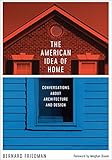The American Idea of Home : Conversations about Architecture and Design / Bernard Friedman.
Material type: TextPublisher: Austin : University of Texas Press, [2021]Copyright date: ©2017Description: 1 online resource (227 p.)Content type:
TextPublisher: Austin : University of Texas Press, [2021]Copyright date: ©2017Description: 1 online resource (227 p.)Content type: - 9781477312889
- 720.973 23
- NA705 .F75 2017
- NA705 .F75 2017
- online - DeGruyter
| Item type | Current library | Call number | URL | Status | Notes | Barcode | |
|---|---|---|---|---|---|---|---|
 eBook
eBook
|
Biblioteca "Angelicum" Pont. Univ. S.Tommaso d'Aquino Nuvola online | online - DeGruyter (Browse shelf(Opens below)) | Online access | Not for loan (Accesso limitato) | Accesso per gli utenti autorizzati / Access for authorized users | (dgr)9781477312889 |
Frontmatter -- CONTENTS -- Foreword: No Place Like It -- Introduction -- PART 1 The Functions and Meanings of Home -- PART 2 History, Tradition, Change -- PART 3 Activism, Sustainability, Environment -- PART 4 Cities, Suburbs, Regions -- PART 5 Technology, Innovation, Materials -- Acknowledgments -- Photography Credits -- Index
restricted access online access with authorization star
http://purl.org/coar/access_right/c_16ec
“Home is an idea,” Meghan Daum writes in her foreword, “a story we tell ourselves about who we are and who and what we want closest in our midst.” In The American Idea of Home, documentary filmmaker Bernard Friedman interviews more than thirty leaders in the field of architecture about a constellation of ideas relating to housing and home. The interviewees include Pritzker Prize winners Thom Mayne, Richard Meier, and Robert Venturi; Pulitzer Prize winners Paul Goldberger and Tracy Kidder; American Institute of Architects head Robert Ivy; and legendary architects such as Denise Scott Brown, Charles Gwathmey, Kenneth Frampton, and Robert A. M. Stern. The American idea of home and the many types of housing that embody it launch lively, wide-ranging conversations about some of the most vital and important issues in architecture today. The topics that Friedman and his interviewees discuss illuminate five overarching themes: the functions and meanings of home; history, tradition, and change in residential architecture; activism, sustainability, and the environment; cities, suburbs, and regions; and technology, innovation, and materials. Friedman frames the interviews with an extended introduction that highlights these themes and helps readers appreciate the common concerns that underlie projects as disparate as Katrina cottages and Frank Lloyd Wright Usonian houses. Readers will come away from these thought-provoking interviews with an enhanced awareness of the “under the hood” kinds of design decisions that fundamentally shape our ideas of home and the dwellings in which we live.
Mode of access: Internet via World Wide Web.
In English.
Description based on online resource; title from PDF title page (publisher's Web site, viewed 26. Apr 2022)


